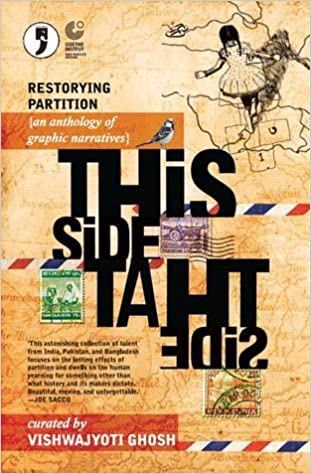Event, memory, metaphor
Published @ Daily News & Analysis

In this book that he has, curiously, curated, graphic storyteller Vishwajyoti Ghosh has attempted to ‘redraw’ the map of Partition. The hyperbolism of the statement can be tempered if we take the literal meaning of the word re-draw, which is to illustrate once again the fault-lines of Partition. This collection of collaborative graphic texts is no less than that. It returns to the event of the biggest forced migration of humanity’s recorded history and tries to re-imagine it through a series of narratives drawn and told across the canvas of South Asia; involving artists and writers from India, Pakistan and Bangladesh – surely the three nations with the biggest stake in Partitions of 1947 and then, again, lest we forget, 1971.
There are few predecessors of This Side, That Side. Unlike the political graphic non-fiction of Joe Sacco, Ghosh is not into existing territories of restive temperament. Unlike Maus, Ghosh is not into a detailed exploration of the terrible memories of Shoah! Ghosh attempts something out of the ordinary- a portmanteau collection, in which narratives connected by the broader theme of Partition come together to form a whole. But before we can comment on that whole, we need to look at the process of it coming together, which is no less interesting. Most narratives of the twenty-eight stories that make up the collection are collaborations between not just a writer and an illustrator but also between two voices from this side and that side, literally. Some of them involve a third voice, that of a translator. This process hence gives the coming together of the book a political edge. The process by which they have come together is perhaps meant to be a comment on the illogic of Partition, if there was ever any logic behind it. Hence individuals and memories, loss and displacement, the absurdity of borders and the forced re-constitution of identities pre-occupy the stories rather than acts of violation, dismemberment and catastrophe. For many, this might mean an act of erasure. But for the reviewer, revisiting Partition from the vantage of lapsed time is only more effective this way.
In terms of the result, like any anthology, it is inevitably mixed. Stories vary widely, so do the illustrations. But one takes home the lingering feeling that the illustrations are often better than the narratives. It is difficult to say if that is something particular to this book or is it because narratives of Partition, starting with Urvashi Butalia’s seminal collection, have been with us for some time now, but not accompanying drawings of the same. For this reviewer at least, the appeal of the book is primarily visual and hence it adds to the niche but important graphic work that India has produced lately. As far it being a Partition anthology, this reviewer would be less likely to call it any major achievement in itself.
The inclusion of Orijit Sen’s cheeky image-montage, Bani Abadi’s video art and a photo-essay in the collection might raise a few heckles from purists of the graphic form. But for this reviewer, all of them add substantially to the spirit of the collection. This Side that Side is a delightful book; if only the stories were better!
comments for this post are closed